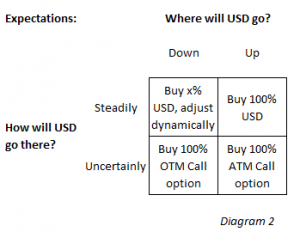treasuryXL Resources (part II): education & training
| 5-1-2017 | Annette Gillhart |
 In december we called in your help to refer to our page ‘Resources‘ and complete our list of associations. We have received interesting suggestions which will be added to the list shortly. Today we would like to give you an overview of the treasury education and training organisations that we have listed on this same page under the tab ‘education and training‘. Of course you are again most welcome to send in suggestions, as we do not claim that this list is complete.
In december we called in your help to refer to our page ‘Resources‘ and complete our list of associations. We have received interesting suggestions which will be added to the list shortly. Today we would like to give you an overview of the treasury education and training organisations that we have listed on this same page under the tab ‘education and training‘. Of course you are again most welcome to send in suggestions, as we do not claim that this list is complete.
As our list is rather long we will start with 3 organisations:
1. Alex van Groningen
Since 1994 Alex van Groningen is one of the leading partners for finance professionals. They also built several major communities with their partners. Within those communities knowledge, network and career meet, support and enforce each other. More than 100.000 professionals meet online and in class rooms.
Training programs comprise amongst others Financial analysis, Strategic financial management, Controller in one week and Business valuation.
2. NCOI
Education and training for working people in The Netherlands.
NCOI stands for keeping skills on a high level or improving these skills and their target group is the working population. Every year they enlarge the knowledge, skills and competence of thousands of working people. Their approach is strongly related to the working practice and offers a high extend of flexiblity to combine job and study. They offer various starting dates, different study types, top lecturers, group lessons and a valuable diploma.
A short summary of the programs they have for treasurers and finance professionals (courses are in Dutch):
Masterclass Financing & Treasury, Module treasury management, Master Finance & Control
3. NIBE-SVV
NIBE-SVV offers education and training for bank, insurance and stock exchange professionals throughout The Netherlands. According to their information they are the leading institute for finance professionals. Courses and programs are matched with the existing knowledge and competences of participants.
Their approach is practical and they provide profession-oriented training on MBO (intermediate vocacional education) , HBO- (higher vocational education) and Master level.
They offer the following programs for treasurers and finance professionals (in Dutch):
Introduction riskmanagement, Financial riskmanagement, Cashmanagement, Financial risk and regulation, Foundation of financial risk, Cashmanagment and Tradefinance
The complete list of education and training organisations on our website can be found under ‘education and training‘.
For more information about a particular organisation and the most recent programs please visit their websites.
Have you been following an interesting and valuable training lately that you want to tell us about? Please feel free to share it with us and the treasury community!
 Annette Gillhart – Community Manager treasuryXL
Annette Gillhart – Community Manager treasuryXL
[button url=”https://www.treasuryxl.com/about/” text=”View profile” size=”small” type=”primary” icon=”” external=”1″]
[separator type=”” size=”” icon=””]



 Er staat op dit moment veel in het nieuws over rentederivaten en de ontwikkelingen rond deze producten. Rentederivaten kunnen nuttig zijn om het renterisico af te dekken, het zijn echter ingewikkelde producten. Als treasurer zult u de werking en de risico’s van het product goed begrijpen. Als u toch behoefte heeft aan voorlichting kunt u zich laten informeren door uw bank. Daarnaast kunt u kennis over de werking van deze producten in huis halen, bijvoorbeeld bij een advieskantoor dat zich specialiseert op het gebied van rentederivaten.
Er staat op dit moment veel in het nieuws over rentederivaten en de ontwikkelingen rond deze producten. Rentederivaten kunnen nuttig zijn om het renterisico af te dekken, het zijn echter ingewikkelde producten. Als treasurer zult u de werking en de risico’s van het product goed begrijpen. Als u toch behoefte heeft aan voorlichting kunt u zich laten informeren door uw bank. Daarnaast kunt u kennis over de werking van deze producten in huis halen, bijvoorbeeld bij een advieskantoor dat zich specialiseert op het gebied van rentederivaten. 
 Waar zondagnacht (11 PM Amsterdamse tijd) de EUR/USD nog een aardige push omlaag kreeg vanwege de ‘Italië-uitkomst’, is dit weer ongedaan gemaakt tijdens de Europese openingsuren. Van paniek is geen sprake, aangezien een beweging van een cent relatief gezien gering is.
Waar zondagnacht (11 PM Amsterdamse tijd) de EUR/USD nog een aardige push omlaag kreeg vanwege de ‘Italië-uitkomst’, is dit weer ongedaan gemaakt tijdens de Europese openingsuren. Van paniek is geen sprake, aangezien een beweging van een cent relatief gezien gering is. Udo Rademakers – Independent Treasury Consultant & Interim Manager
Udo Rademakers – Independent Treasury Consultant & Interim Manager



 Recently the Dutch Ministry of Finance appointed three independent experts to solve the long-lasting issue of derivatives mis-selling in the Netherlands. This is important for both firms and banks as the dispute puts severe pressure on their relationship. Moreover, judges are reaching more and more verdicts in favour of SME’s. In several cases interest rate swap transactions were declared void and the firm was compensated for its losses. Therefore the stakes are high. Is this last step permanently going to solve the issue?
Recently the Dutch Ministry of Finance appointed three independent experts to solve the long-lasting issue of derivatives mis-selling in the Netherlands. This is important for both firms and banks as the dispute puts severe pressure on their relationship. Moreover, judges are reaching more and more verdicts in favour of SME’s. In several cases interest rate swap transactions were declared void and the firm was compensated for its losses. Therefore the stakes are high. Is this last step permanently going to solve the issue?
 10-05-2016 | By
10-05-2016 | By 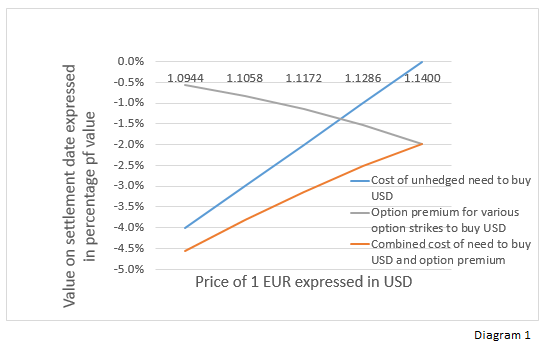
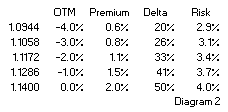 Risk appears fairly stabile across strikes, which makes sense because the premiums are calculated with one volatility on one underlying. The Risk on OTM is lower than that for ATM options. It appears that OTM premiums are relatively more expensive, they give protection against less potential loss.
Risk appears fairly stabile across strikes, which makes sense because the premiums are calculated with one volatility on one underlying. The Risk on OTM is lower than that for ATM options. It appears that OTM premiums are relatively more expensive, they give protection against less potential loss.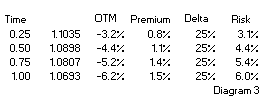 Diagram 3 shows Premiums, Delta and Risk for different tenors. ‘Time’ is the time to expiry of the options in fractions of years. Its shows that for longer tenors, the Risk is higher. But disproportionally. For the same chance on exercise a hedger could double the premium to buy a hedge for a 4x longer tenor.
Diagram 3 shows Premiums, Delta and Risk for different tenors. ‘Time’ is the time to expiry of the options in fractions of years. Its shows that for longer tenors, the Risk is higher. But disproportionally. For the same chance on exercise a hedger could double the premium to buy a hedge for a 4x longer tenor.
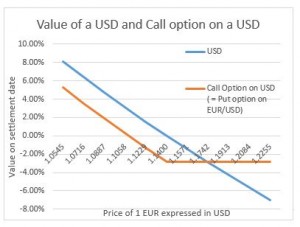 Diagram 1 explains his feelings. I assume he was considering only the left half of the payoff diagram. After an appreciation of the USD, a USD is always worth more than a call option on a USD, the difference being the option premium.
Diagram 1 explains his feelings. I assume he was considering only the left half of the payoff diagram. After an appreciation of the USD, a USD is always worth more than a call option on a USD, the difference being the option premium.